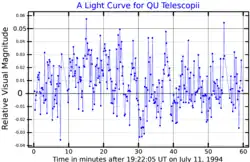EC 20058-5234
EC 20058-5234 (QU Telescopii), is a star in the constellation Telescopium. With an apparent magnitude of 15.03,[3] it's impossible to detect with the naked eye and requires a powerful telescope to be seen; this degenerate object is located 388 light years from the Solar System based on parallax.[2]
| Observation data Epoch J2000.0 Equinox J2000.0(ICRS) | |
|---|---|
| Constellation | Telescopium |
| Right ascension | 20h 09m 40.19s[2] |
| Declination | −52° 25′ 15.86″[2] |
| Apparent magnitude (V) | 15.03[3] |
| Characteristics | |
| Evolutionary stage | white dwarf |
| Spectral type | DB2[4] |
| U−B color index | −0.71[5] |
| B−V color index | −0.04[5] |
| Variable type | V777 Herculis[6] |
| Astrometry | |
| Proper motion (μ) | RA: +12.024 mas/yr[2] Dec.: -76.714 mas/yr[2] |
| Parallax (π) | 8.4145 ± 0.0650 mas[2] |
| Distance | 388 ± 3 ly (118.8 ± 0.9 pc) |
| Details | |
| Mass | 0.569 ± 0.022[7] M☉ |
| Surface gravity (log g) | 7.91 ± 0.05[8] cgs |
| Temperature | 24,843 ± 1,363[7] K |
| Other designations | |
QU Telescopii, Gaia DR2 6665910709364014336 | |
| Database references | |
| SIMBAD | data |
QU Telescopii has a classification of DB2, which states it's a white dwarf with He I lines present in its atmosphere. At the moment, it has 56.9% the mass of the Sun,[7] but a high surface gravity suggests QU Telescopii has a low radius.[8] It has an effective temperature of 24,843 K,[7] which gives it a blue hue as opposed to a white hue. QU Telescopii belongs to a class of stars known as V777 Herculis variables or DBV stars.[6] First noticed in the Edinburgh-Cape Blue Object Survey published in 1992, it was found to be variable in 1995.[1]
References
- Koen, C.; O'Donoghue, D.; Stobie, R. S.; Kilkenny, D.; Ashley, R. (1995). "EC 20058-5234, a low-amplitude pulsating DB white dwarf". Monthly Notices of the Royal Astronomical Society. 277 (3): 913–19. Bibcode:1995MNRAS.277..913K. doi:10.1093/mnras/277.3.913.
- Brown, A. G. A.; et al. (Gaia collaboration) (August 2018). "Gaia Data Release 2: Summary of the contents and survey properties". Astronomy & Astrophysics. 616. A1. arXiv:1804.09365. Bibcode:2018A&A...616A...1G. doi:10.1051/0004-6361/201833051. Gaia DR2 record for this source at VizieR.
- O'Donoghue, D.; Kilkenny, D.; Koen, C.; Hambly, N.; MacGillivray, H.; Stobie, R. S. (May 2013). "The Edinburgh-Cape Blue Object Survey - III. Zone 2; galactic latitudes -30° > b > -40°". Monthly Notices of the Royal Astronomical Society. 431 (1): 240–251. Bibcode:2013MNRAS.431..240O. doi:10.1093/mnras/stt158. ISSN 0035-8711.
- Beauchamp, A.; Wesemael, F.; Bergeron, P.; Fontaine, G.; Saffer, R. A.; Liebert, J.; Brassard, P. (May 1999). "Spectroscopic Studies of DB White Dwarfs: The Instability Strip of the Pulsating DB (V777 Herculis) Stars". The Astrophysical Journal. 516 (2): 887–891. Bibcode:1999ApJ...516..887B. doi:10.1086/307148. ISSN 0004-637X. S2CID 122092777.
- McCook, G. P.; Sion, E. M. (2016). "A Catalogue of Spectroscopically Identified White Dwarfs". VizieR Online Data Catalog. 1: 2035. Bibcode:2016yCat....1.2035M.
- BSJ (11 November 2011). "QU Telescopii". AAVSO Website. American Association of Variable Star Observers. Retrieved 26 June 2014.
- Gentile Fusillo, Nicola Pietro; Tremblay, Pier-Emmanuel; Gänsicke, Boris T; Manser, Christopher J; Cunningham, Tim; Cukanovaite, Elena; Hollands, Mark; Marsh, Thomas; Raddi, Roberto; Jordan, Stefan; Toonen, Silvia; Geier, Stephan; Barstow, Martin; Cummings, Jeffrey D (February 2019). "A Gaia Data Release 2 catalogue of white dwarfs and a comparison with SDSS". Monthly Notices of the Royal Astronomical Society. 482 (4): 4570–4591. arXiv:1807.03315. Bibcode:2019MNRAS.482.4570G. doi:10.1093/mnras/sty3016.
- Gentile Fusillo, N P; Tremblay, P-E; Cukanovaite, E; Vorontseva, A; Lallement, R; Hollands, M; Gänsicke, B T; Burdge, K B; McCleery, J; Jordan, S (22 October 2021). "A catalogue of white dwarfs in Gaia EDR3". Monthly Notices of the Royal Astronomical Society. 508 (3): 3877–3896. arXiv:2106.07669. Bibcode:2021MNRAS.508.3877G. doi:10.1093/mnras/stab2672.
